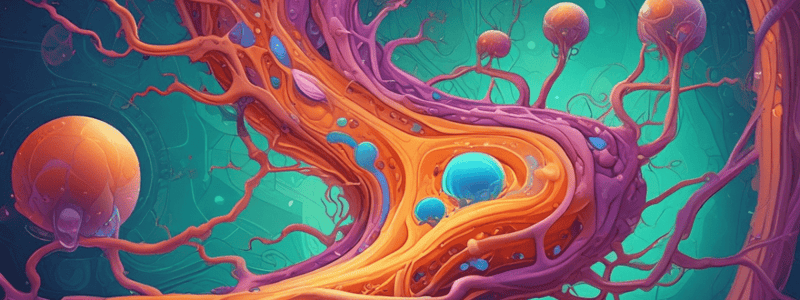Podcast
Questions and Answers
What is the primary driving force behind the process of diffusion?
What is the primary driving force behind the process of diffusion?
- Thermal energy causing collisions of molecules
- ATP energy molecules
- Contractile vacuoles expelling fluids
- Concentration gradient between regions (correct)
In which direction do molecules move during diffusion?
In which direction do molecules move during diffusion?
- Towards an area of higher concentration
- In a circular motion
- Towards an area of lower concentration (correct)
- Randomly with no particular direction
Which of the following is a necessary condition for diffusion to occur?
Which of the following is a necessary condition for diffusion to occur?
- A semi-permeable membrane
- A concentration gradient (correct)
- An area with zero concentration
- The presence of ATP
What would likely happen to diffusion if the concentration gradient between two areas decreases?
What would likely happen to diffusion if the concentration gradient between two areas decreases?
Which statement best characterizes diffusion?
Which statement best characterizes diffusion?
Which term describes the process by which water molecules move across a semipermeable membrane?
Which term describes the process by which water molecules move across a semipermeable membrane?
Which type of solution has a higher concentration of solutes outside the cell than inside?
Which type of solution has a higher concentration of solutes outside the cell than inside?
What is a characteristic feature of active transport?
What is a characteristic feature of active transport?
Which of the following best describes facilitated diffusion?
Which of the following best describes facilitated diffusion?
What is a key difference between passive and active transport?
What is a key difference between passive and active transport?
Which process involves the cell membrane engulfing materials to bring them into the cell?
Which process involves the cell membrane engulfing materials to bring them into the cell?
What is the primary function of aquaporins in the cell membrane?
What is the primary function of aquaporins in the cell membrane?
Why is facilitated diffusion important for cellular processes?
Why is facilitated diffusion important for cellular processes?
In an osmotic system, the side with higher concentration of sugar will have what kind of solution?
In an osmotic system, the side with higher concentration of sugar will have what kind of solution?
What happens to the water movement when the concentration of water becomes equal on both sides of the membrane?
What happens to the water movement when the concentration of water becomes equal on both sides of the membrane?
Which of the following statements best describes the direction of net water movement in osmosis?
Which of the following statements best describes the direction of net water movement in osmosis?
What does 'selectively permeable' mean in the context of cell membranes?
What does 'selectively permeable' mean in the context of cell membranes?
How does the concept of osmosis explain the movement of water in Figure 8.18?
How does the concept of osmosis explain the movement of water in Figure 8.18?
What term describes a solution with lower solute concentration compared to another solution?
What term describes a solution with lower solute concentration compared to another solution?
What is the movement of water when a cell is placed in a hypertonic solution?
What is the movement of water when a cell is placed in a hypertonic solution?
How does a hypotonic solution affect an animal cell?
How does a hypotonic solution affect an animal cell?
What happens to a plant cell in an isotonic solution?
What happens to a plant cell in an isotonic solution?
What causes water to move into a cell in a hypotonic solution?
What causes water to move into a cell in a hypotonic solution?
Which effect does a hypertonic solution have on a plant cell?
Which effect does a hypertonic solution have on a plant cell?
How does the net movement of water occur in isotonic solutions for animal cells?
How does the net movement of water occur in isotonic solutions for animal cells?
Why does osmotic pressure develop across a cell membrane?
Why does osmotic pressure develop across a cell membrane?
What does the semipermeable membrane control in cells?
What does the semipermeable membrane control in cells?
Which type of cell membrane transport mechanism is primarily responsible for maintaining cell volume?
Which type of cell membrane transport mechanism is primarily responsible for maintaining cell volume?
What is the primary difference between active transport and diffusion?
What is the primary difference between active transport and diffusion?
Which cell structure is directly involved in the active transport of large molecules?
Which cell structure is directly involved in the active transport of large molecules?
How does bulk transport differ from other forms of cell membrane transport?
How does bulk transport differ from other forms of cell membrane transport?
Which transport mechanism involves the cell membrane folding inward to enclose molecules?
Which transport mechanism involves the cell membrane folding inward to enclose molecules?
Why is active transport critical for cells?
Why is active transport critical for cells?
How does the sodium pump contribute to molecular transport?
How does the sodium pump contribute to molecular transport?
What role do synthesizers play in cell membrane transport?
What role do synthesizers play in cell membrane transport?
What occurs immediately after the pocket that results from endocytosis breaks loose from the cell membrane?
What occurs immediately after the pocket that results from endocytosis breaks loose from the cell membrane?
Which process involves the extensions of cytoplasm surrounding and packaging a particle within a food vacuole?
Which process involves the extensions of cytoplasm surrounding and packaging a particle within a food vacuole?
What is one specific function of phagocytosis in white blood cells?
What is one specific function of phagocytosis in white blood cells?
In exocytosis, what occurs when the membrane of a vesicle fuses with the cell membrane?
In exocytosis, what occurs when the membrane of a vesicle fuses with the cell membrane?
Which type of endocytosis do amoebas use to take in food?
Which type of endocytosis do amoebas use to take in food?
How do aquaporins assist in the process of osmosis?
How do aquaporins assist in the process of osmosis?
What is one example of exocytosis mentioned in the text?
What is one example of exocytosis mentioned in the text?
What does the process of endocytosis enable cells to take up?
What does the process of endocytosis enable cells to take up?
Study Notes
Cell Transport
- Cells have internal systems that distribute and deliver support, and boundaries that separate the cell from its surroundings.
Passive Transport
- Diffusion: the movement of molecules from an area of higher concentration to an area of lower concentration.
- Osmosis: the movement of water molecules through a selectively permeable membrane from an area of higher concentration to an area of lower concentration.
- Facilitated Diffusion: a type of passive transport that uses specialized channels called aquaporins to move molecules through the cell membrane without using energy.
Osmosis
- Osmosis is a type of facilitated diffusion that occurs through specialized channels called aquaporins.
- Osmosis is the movement of water molecules through a selectively permeable membrane from an area of higher concentration to an area of lower concentration.
- Osmotic pressure is controlled by the net movement of water across the cell's semipermeable membrane, affected by the concentration of solutes.
Effects of Osmosis on Cells
- Hypertonic solution: a solution with a higher concentration of solutes than the cell, causing water to leave the cell.
- Hypotonic solution: a solution with a lower concentration of solutes than the cell, causing water to enter the cell.
- Isotonic solution: a solution with the same concentration of solutes as the cell, causing no net movement of water.
Active Transport
- Active Transport: a semi-permeable membrane transport process that moves material against a concentration difference, requiring energy.
- Used to maintain cell volume and create gradients for other substances.
- Example: Sodium Pump, which uses ATP to pump sodium and potassium ions across the cell membrane.
Cell Membrane Transport
- Synthesizers: proteins that bind molecules to transport across the cell membrane.
- Endocytosis: a method of cell transport where the cell membrane folds inward and encloses molecules to form a transport vesicle.
Bulk Transport
- Bulk Transport: the movement of very solid clumps of material across the cell membrane.
- Used to remove large amounts of waste or produce a larger cell.
Endocytosis and Exocytosis
- Endocytosis: the process of taking material into the cell by means of infoldings or pockets of the cell membrane.
- Phagocytosis: a type of endocytosis in which extensions of cytoplasm surround a particle and package it within a food vacuole.
- Exocytosis: the release of large amounts of material from the cell, where the membrane of a vesicle surrounding the material fuses with the cell membrane, forcing the contents out of the cell.
Studying That Suits You
Use AI to generate personalized quizzes and flashcards to suit your learning preferences.
Description
Understand the different types of cell transport, including passive and active transport, and how they work. Learn about diffusion, osmosis, and bulk transport.




